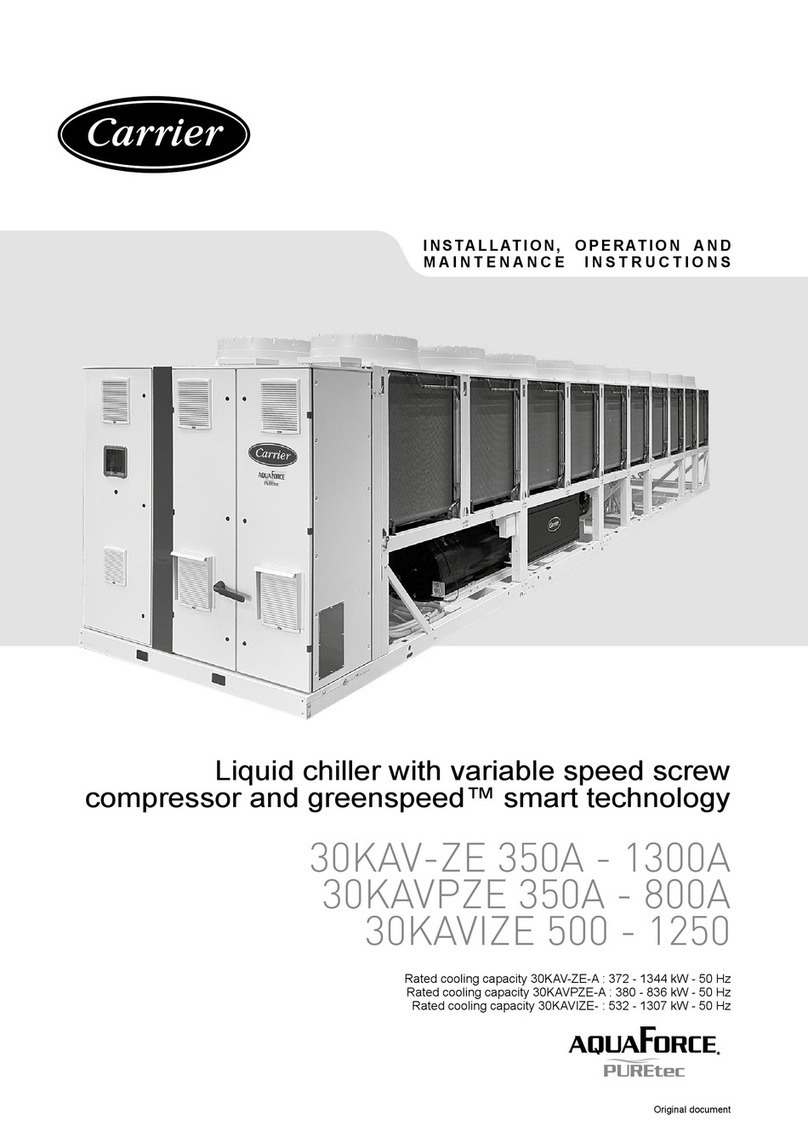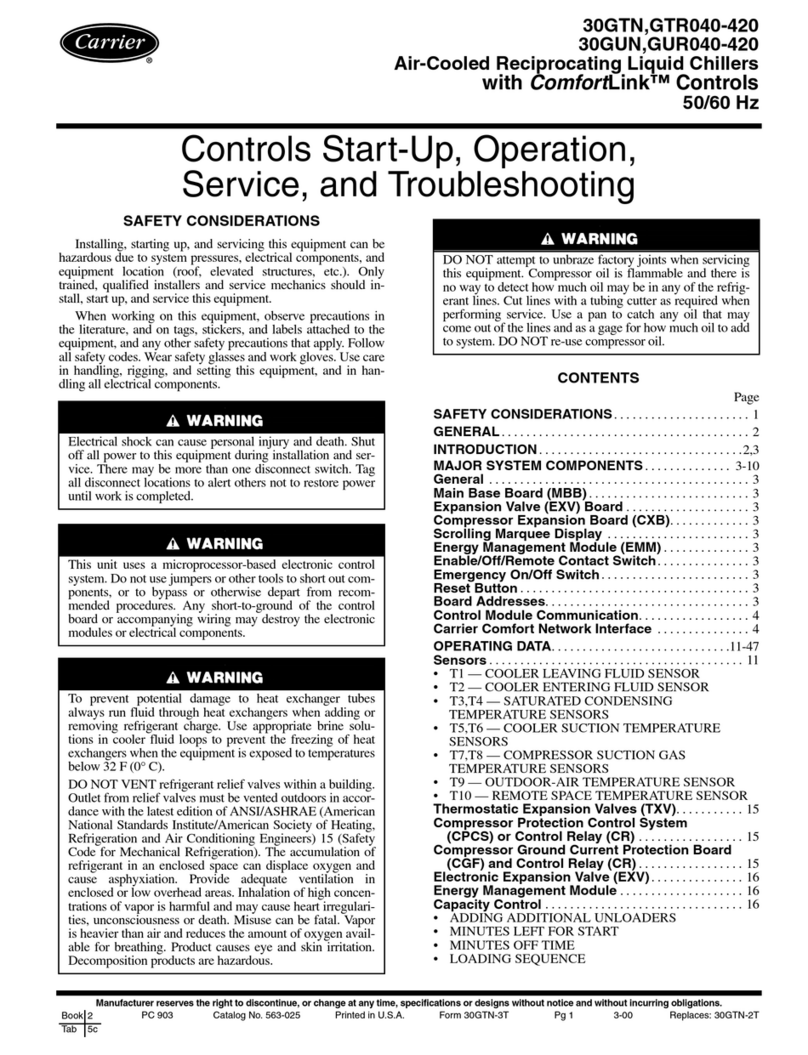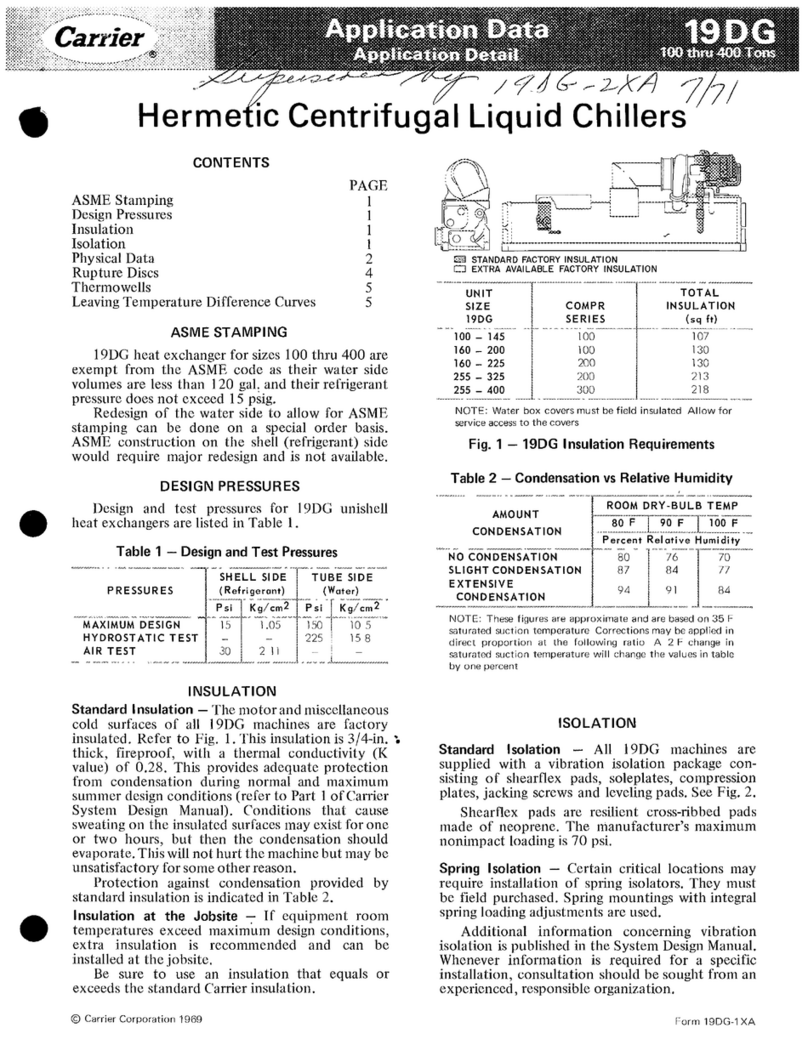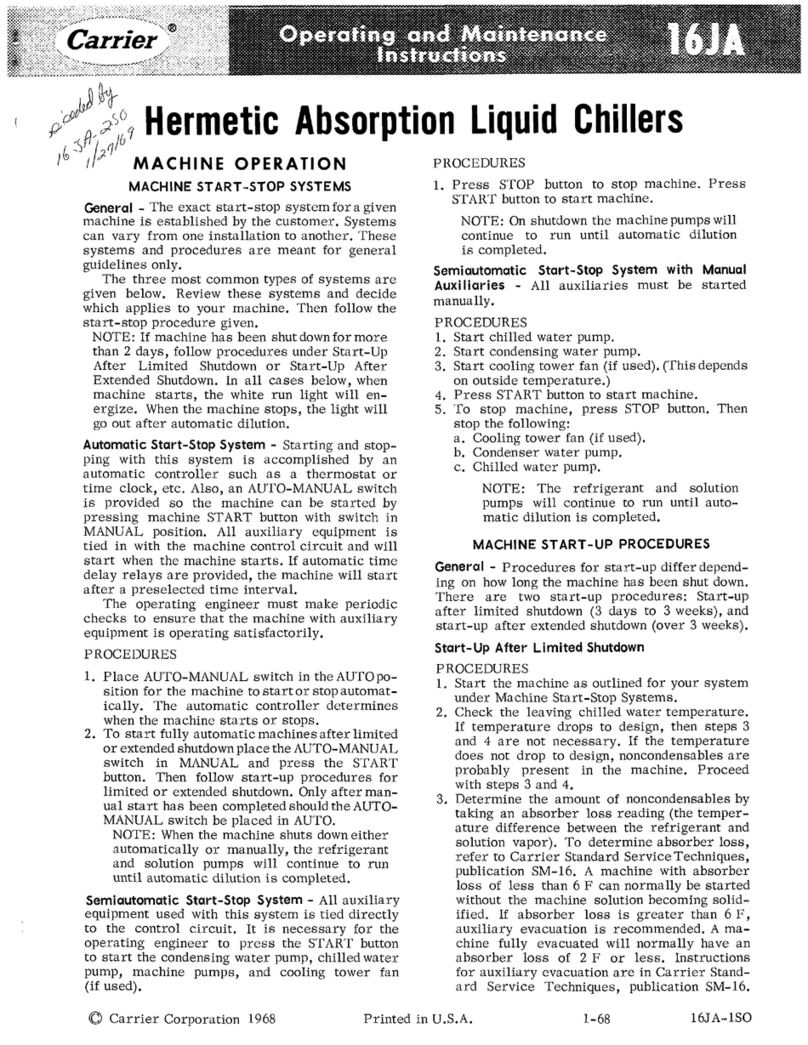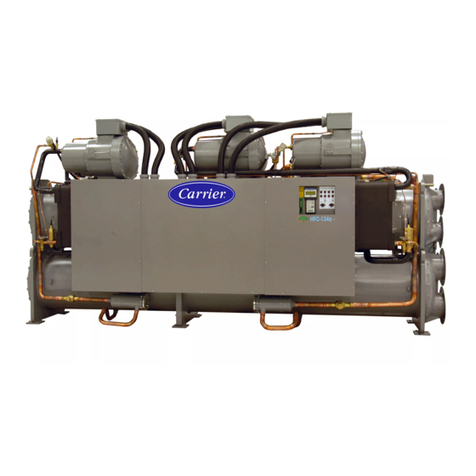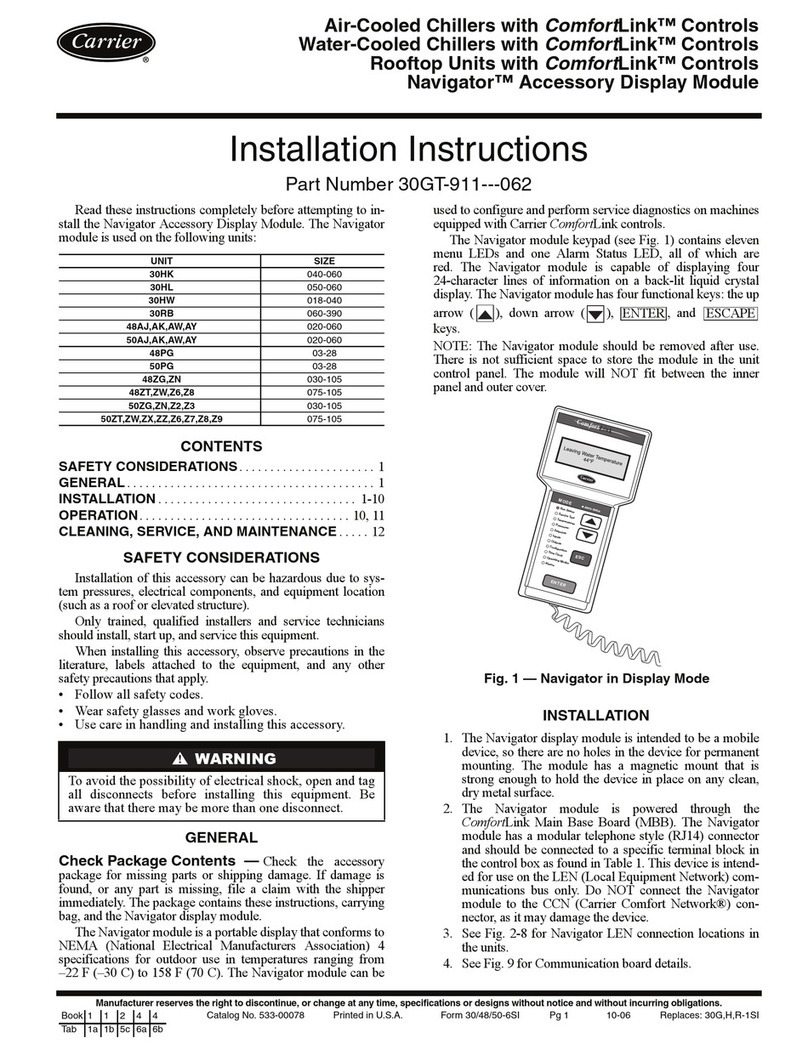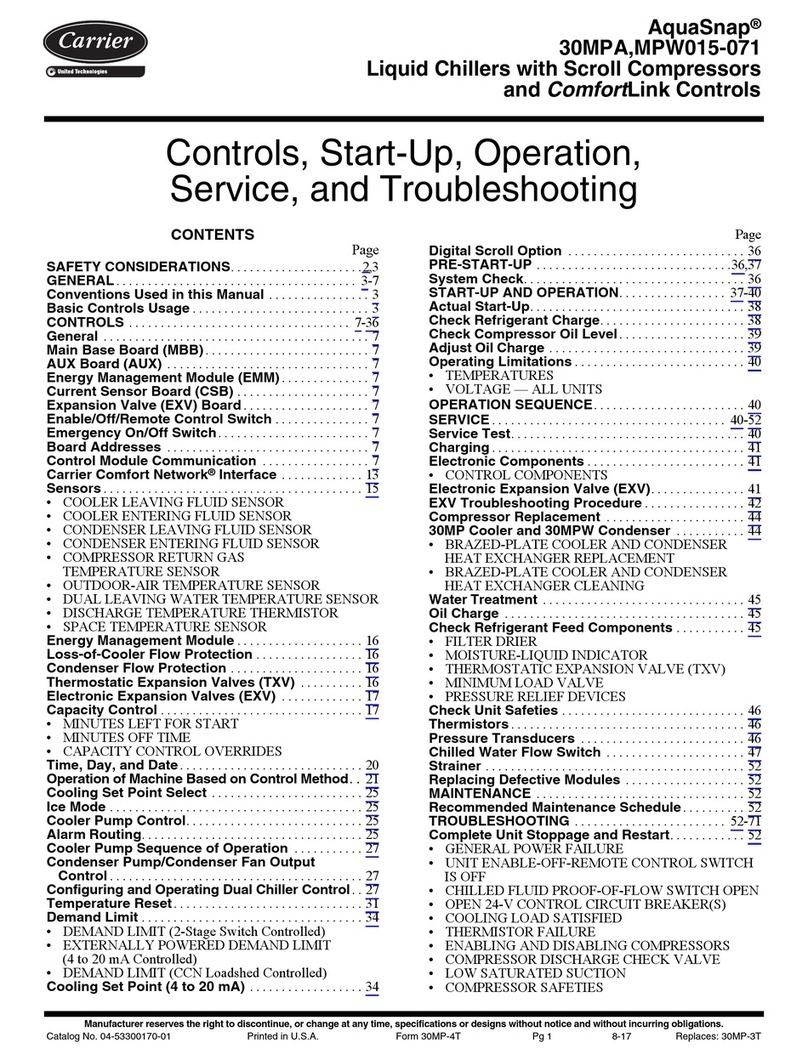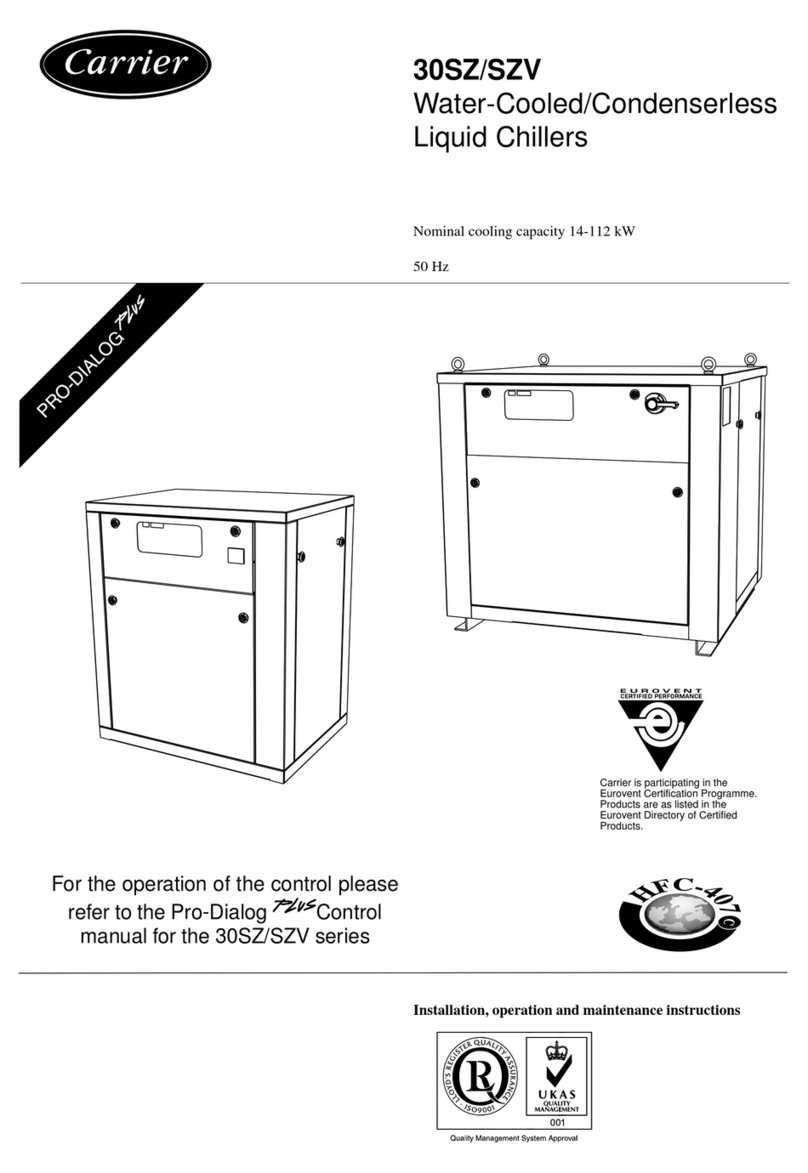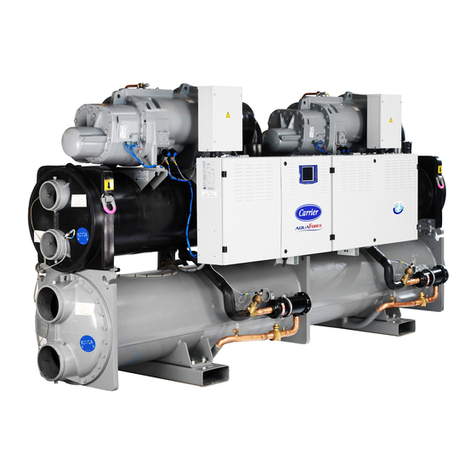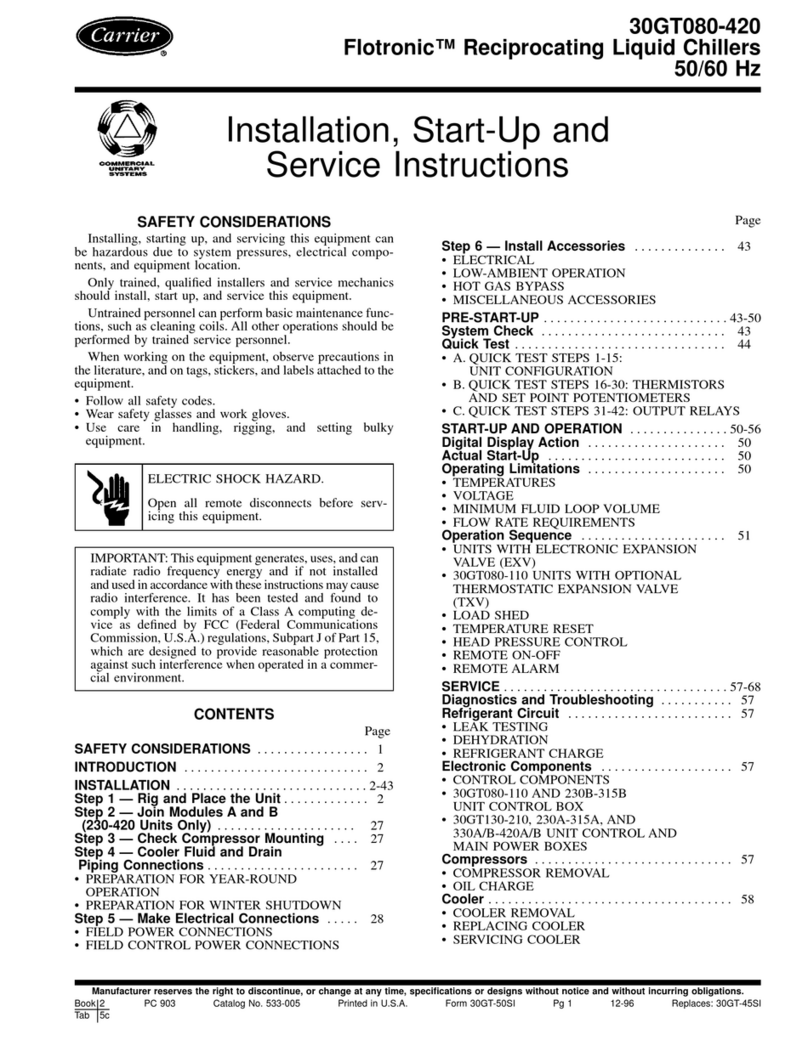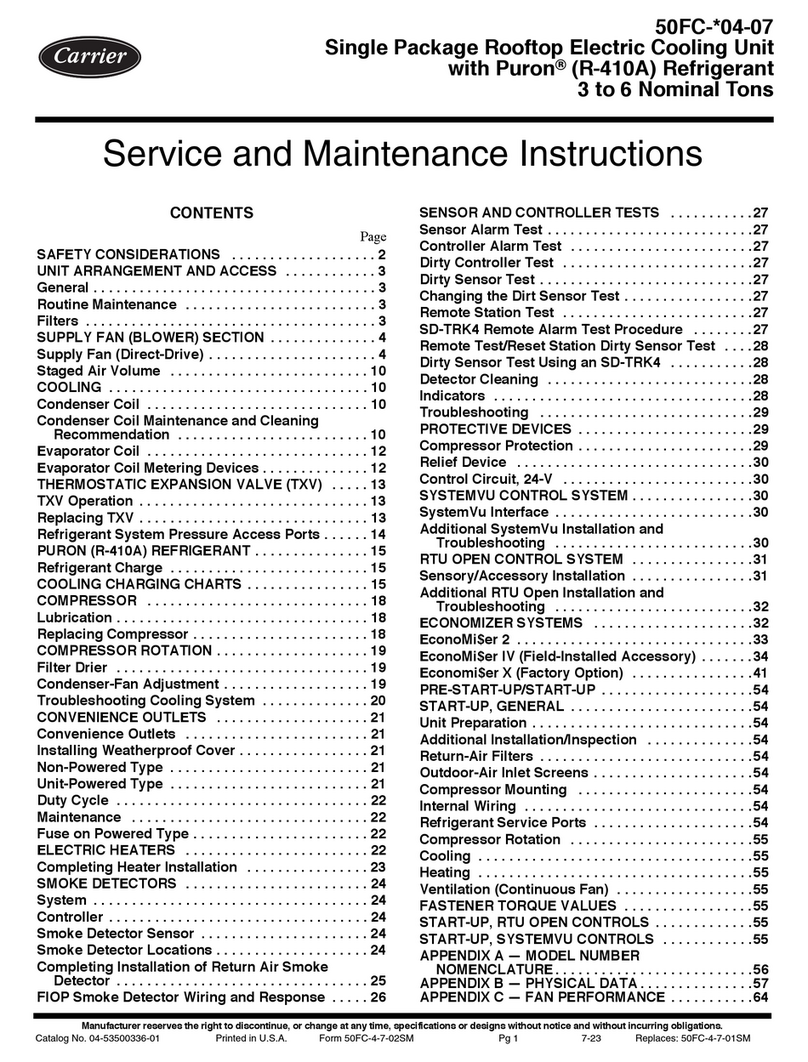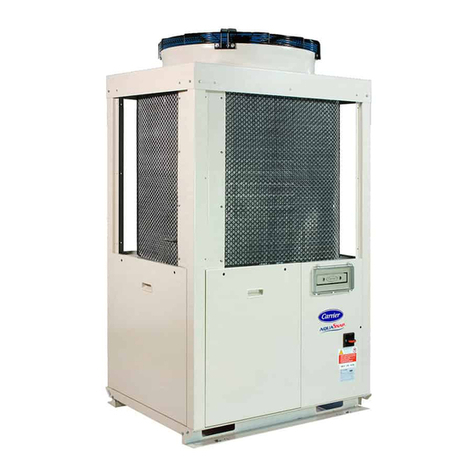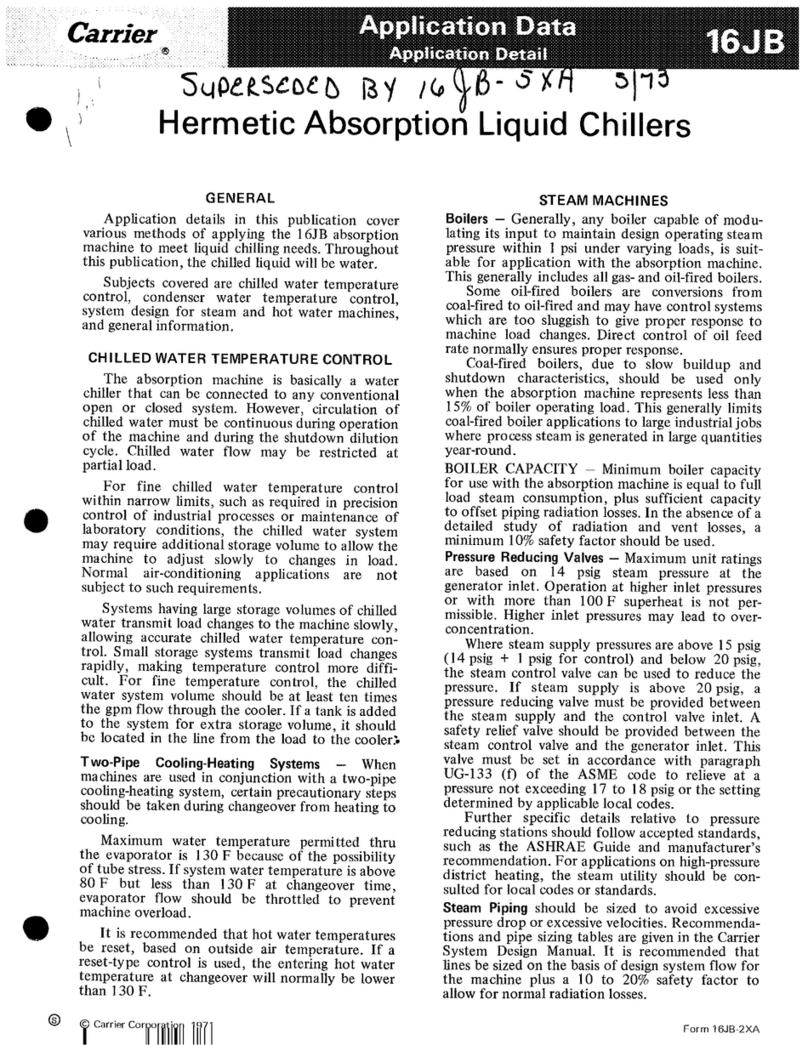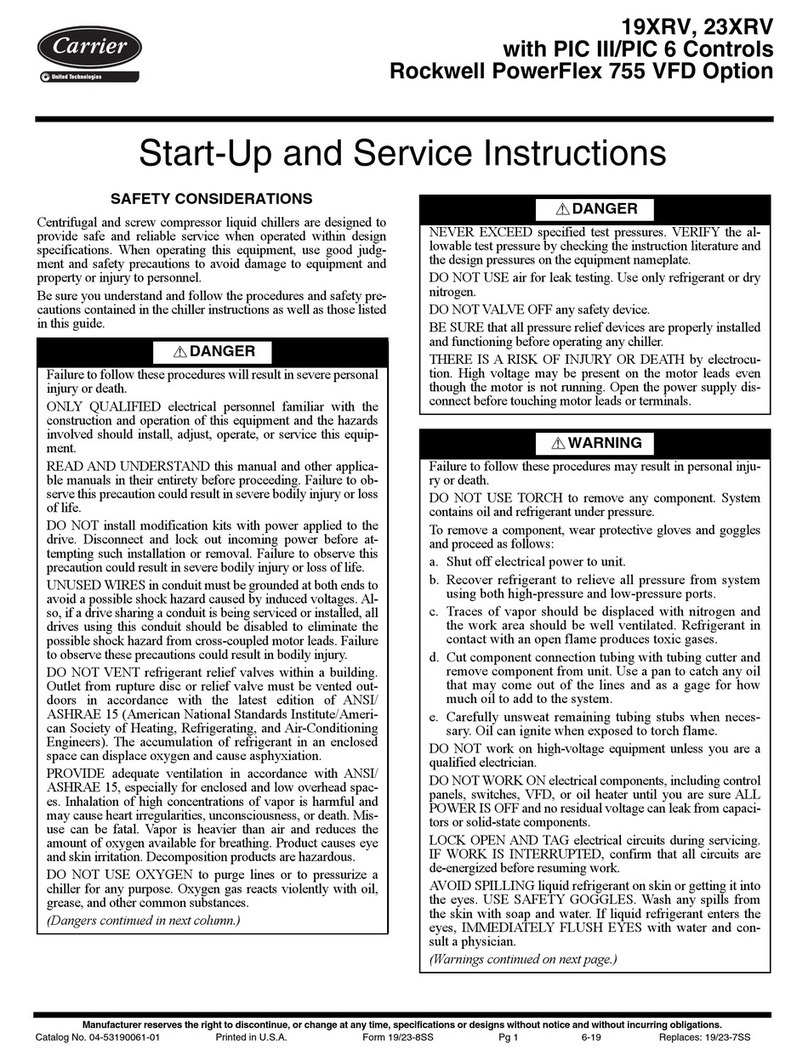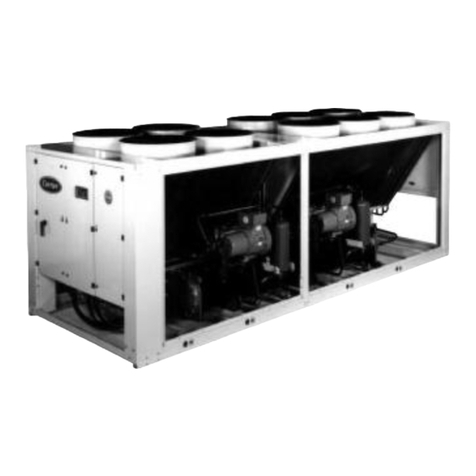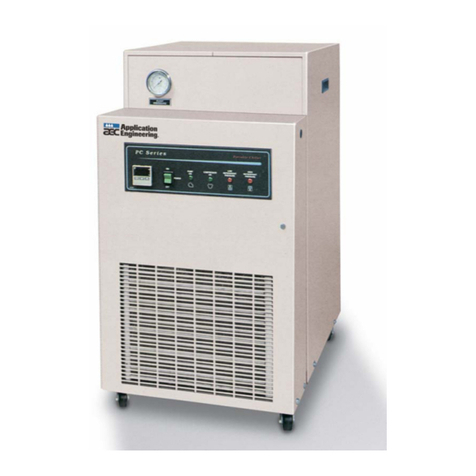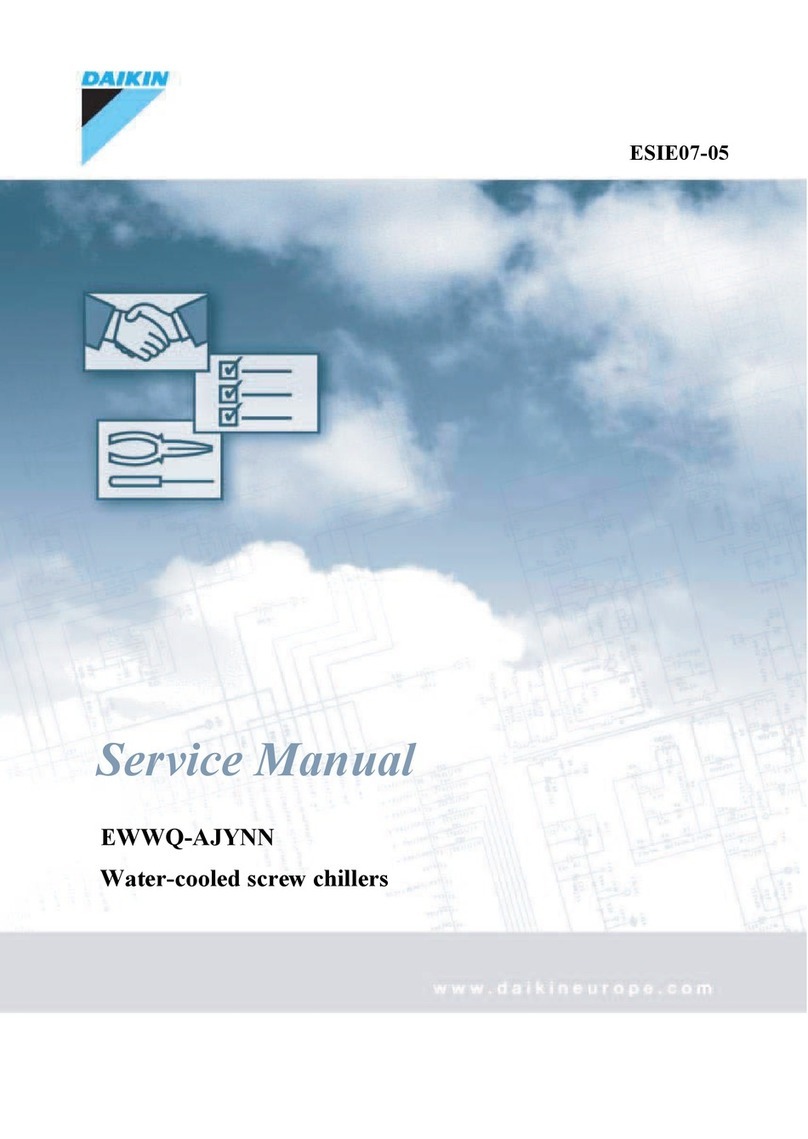
Manufacturer reserves the right to discontinue, or change at any time, specifications or designs without notice and without incurring obligations.
Catalog No. 04-53190083-01 Printed in U.S.A. Form 19DV-CLT-5T Pg 1 5-21 Replaces: 19DV-CLT-4T
Controls Operation and Troubleshooting
SAFETY CONSIDERATIONS . . . . . . . . . . . . . . . . . . . . 1
GENERAL . . . . . . . . . . . . . . . . . . . . . . . . . . . . . . . . . . . 2
Abbreviations Used in This Manual . . . . . . . . . . . . . . 2
HARDWARE . . . . . . . . . . . . . . . . . . . . . . . . . . . . . . . . . 2
Main Control Board . . . . . . . . . . . . . . . . . . . . . . . . . . . 2
SIOB (Starfire Input/Output Board) . . . . . . . . . . . . . . 2
IOB (Input/Output Board) . . . . . . . . . . . . . . . . . . . . . . 2
Communication Cables . . . . . . . . . . . . . . . . . . . . . . . 11
Sensors . . . . . . . . . . . . . . . . . . . . . . . . . . . . . . . . . . . . 11
Controls Outputs . . . . . . . . . . . . . . . . . . . . . . . . . . . . 11
USER INTERFACE . . . . . . . . . . . . . . . . . . . . . . . . . . . 11
Web Connection. . . . . . . . . . . . . . . . . . . . . . . . . . . . . 11
General Interface Features . . . . . . . . . . . . . . . . . . . . 12
CONTROL OPERATION . . . . . . . . . . . . . . . . . . . . . . . 16
Start-Stop Control . . . . . . . . . . . . . . . . . . . . . . . . . . . 16
Compressor Run Status . . . . . . . . . . . . . . . . . . . . . . 16
Chiller Start-Up Sequence. . . . . . . . . . . . . . . . . . . . . 16
Chiller Shutdown Sequence . . . . . . . . . . . . . . . . . . . 17
Refrigerant Lubrication Control . . . . . . . . . . . . . . . . 17
Control Points . . . . . . . . . . . . . . . . . . . . . . . . . . . . . . 18
Displaying Data Trends . . . . . . . . . . . . . . . . . . . . . . . 26
Hydraulic Option . . . . . . . . . . . . . . . . . . . . . . . . . . . . 26
DIAGNOSTICS AND TROUBLESHOOTING . . . . . . . 27
Alarm/Alert Codes . . . . . . . . . . . . . . . . . . . . . . . . . . . 27
Displaying Alarms . . . . . . . . . . . . . . . . . . . . . . . . . . . 27
Resetting Alarms . . . . . . . . . . . . . . . . . . . . . . . . . . . . 27
Event States . . . . . . . . . . . . . . . . . . . . . . . . . . . . . . . . 42
CONTROLLER SETTINGS . . . . . . . . . . . . . . . . . . . . . 42
Unit IP Address . . . . . . . . . . . . . . . . . . . . . . . . . . . . . 42
System Configuration . . . . . . . . . . . . . . . . . . . . . . . . 43
COMMUNICATION PROBLEMS . . . . . . . . . . . . . . . . 43
Hardware Problems . . . . . . . . . . . . . . . . . . . . . . . . . . 43
Web Interface Problems . . . . . . . . . . . . . . . . . . . . . . 43
Ethernet/IP Connection Problems . . . . . . . . . . . . . . 44
APPENDIX A —PIC6 SCREEN AND TABLE
STRUCTURE. . . . . . . . . . . . . . . . . . . . . . . . . . . . . . 46
APPENDIX B —IOB AND HMI DIP SWITCH
SETTINGS. . . . . . . . . . . . . . . . . . . . . . . . . . . . . . . . 82
APPENDIX C —INPUT/OUTPUT BOARD (IOB)
STATUS INDICATORS . . . . . . . . . . . . . . . . . . . . . . 83
APPENDIX D —NETWORK CONFIGURATION . . . . 84
SAFETY CONSIDERATIONS
Installing, starting up, and servicing this equipment can be haz-
ardous due to system pressures, electrical components, and
equipment location (roof, elevated structures, etc.). Only trained,
qualified installers and service mechanics should install, start up,
and service this equipment. When working on this equipment,
observe precautions in the literature, and on tags, stickers, and
labels attached to the equipment, and any other safety precau-
tions that apply. Follow all safety codes. Wear safety glasses and
work gloves. Use care in handling, rigging, and setting this
equipment, and in handling all electrical components.
DANGER
ELECTRICAL SHOCK HAZARD
Failure to follow this warning will result in personal injury
or death.
Before performing service or maintenance operations on
unit, turn off main power switch to unit and install lock(s)
and lockout tag(s). Ensure electrical service to rooftop unit
agrees with voltage and amperage listed on the unit rating
plate. Unit may have more than one power switch.
WARNING
Electrical currents cause components to get hot either tempo-
rarily or permanently and may cause burns. Handle power
cable, electrical cables and conduits, terminal box covers,
and motor frames with great care.
CAUTION
This unit uses a microprocessor control system. Do not
short or jumper between terminations on circuit boards or
modules; control or board failure may result.
Be aware of electrostatic discharge (static electricity) when
handling or making contact with circuit boards or module con-
nections. Always touch a chassis (grounded) part to dissipate
body electrostatic charge before working inside control center.
Use extreme care when handling tools near boards and
when connecting or disconnecting terminal plugs. Circuit
boards can easily be damaged. Always hold boards by the
edges and avoid touching components and connections.
This equipment uses, and can radiate, radio frequency energy.
If not installed and used in accordance with the instruction
manual, it may cause interference to radio communications.
The PIC6 control boards have been tested and found to com-
ply with the limits for a Class A computing device pursuant to
International Standard in North America EN 61000-2/3 which
are designed to provide reasonable protection against such in-
terference when operated in a commercial environment. Oper-
ation of this equipment in a residential area is likely to cause
interference, in which case the user, at his own expense, will
be required to take whatever measures may be required to cor-
rect the interference.
Always store and transport replacement or defective boards
in anti-static shipping bag.
AquaEdge®
19DV Two-Stage High-Efficiency
Semi-Hermetic Centrifugal Liquid Chillers
with PIC6 Controls
